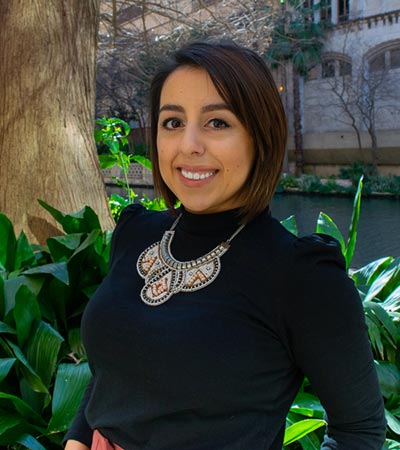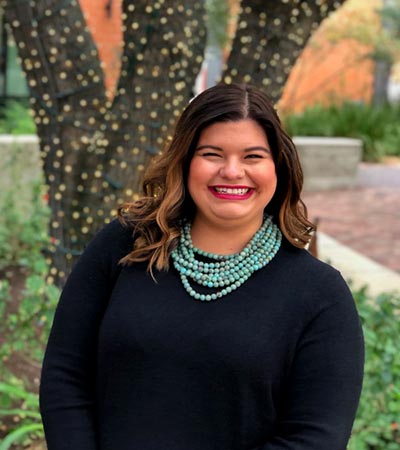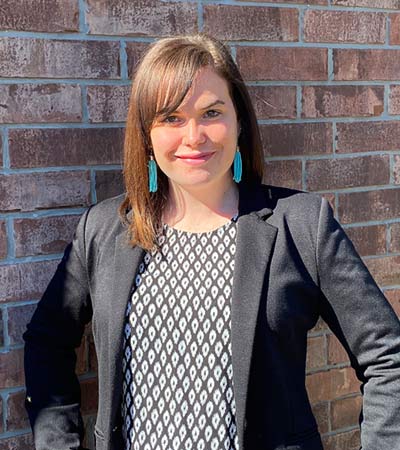August 2021 GPS Career Story: Bianca Alvarez, Kimberly Mirelez, and Jordyn Patrias: Bringing Art and Expertise to the City of San Antonio
August 12, 2021
Graduate and Postdoctoral Success

Bianca Alvarez
Bianca Alvarez
You’ve got ~ a minute or 350 words to give us your elevator pitch. Who are you? What are you all about?
My name is Bianca Alvarez—a native San Antonian, mother to Toad (my daughter’s nickname) and Pepper (my dog), professional art lover, and proud UTSA graduate (MA Art History and Criticism; BFA Painting). Currently, I am a Public Art Project Manager for the City of San Antonio’s Department of Arts & Culture. Passionate for our community, this role has taken me to every corner of the city, with the aspiration of leaving a mark in time defined by beauty and hope that can be accessible to all—through public art. With an emphasis on equity and amplifying diverse voices and narratives, working for the City has allowed me to marry and employ my own personal mission when approaching various projects.
Prior to, I worked across departments at the McNay Art Museum, first in Curatorial followed by Development. One of my fondest memories of working there was the opportunity to be part of the curatorial team who organized the award-winning exhibition Transamerica/n: Gender, Identity, Appearance Today (2019) which earned the Association of Art Museum Curators (AAMC) Curatorial Award of Excellence (2020). This afforded me a chance to channel and apply my artist-activist proclivity to develop an exhibition that was about who we are and how we present ourselves to the world with the goal of highlighting the intersectionality of our shared human experience.
As a curious collector of information, I found my time as a university educator of Art History at UTSA and Baptist University of the Americas to be so fulfilling. The gaining and sharing of knowledge continuously fed my insatiable art nerd appetite. Looking back, I would say that each opportunity allowed for not only self-exploration and growth but allowed me to be part of something larger than myself—something impactful—which makes all the hard work worth it.
Did you ever think about quitting graduate school? What kept you going? Or why did you decide to leave?
Short answer – Yes! Of course, I thought about quitting graduate school, but I am so glad that I pushed through. At the beginning of my second year in the Art History and Criticism program, I discovered I was pregnant. Although my partner/child’s father was supportive, it was still unexpected. All I could think about were the immediate challenges ahead of me—the road below my feet, rather than the destination which seemed impossible to reach. I still had to get through a semester of classes, comp exams, and writing a thesis the following year, while growing a human and working three jobs at the time.
Anticipating the possibility of poor performance in the program and before my GPA would take a hit, I felt like I needed to gracefully exit to prioritize my health, and in turn, my baby’s health—especially if I hoped to return and complete the program. Immediately, I contacted my advisor/mentor and scheduled a meeting. This is where I learned a lesson in humility through candor and vulnerability. After hearing my plan, my advisor (a single mother and professor whom I greatly admired) helped put things into context. We created overlapping timelines for completion of the program that coincided with my pregnancy and delivery. She illustrated multiple paths and viable options that supported me staying in the program. She also shared the bleak likelihood of returning to the program after a life-altering event such as motherhood and the ample opportunities that come with a Master’s degree. Knowing myself, I knew she was right. She was my biggest advocate. If I were to stay, I knew my success was her priority.
The following two years were some of the most challenging. Throughout that time, we checked in regularly and reviewed next steps. Establishing good, strong relationships with her and my other professors was critical. For emotional and moral support, I leaned on my family and friends and surrounded myself with people pursuing their own dreams. We held each other accountable. Ultimately, I had to envision myself at the finish line. Once I was able to shift perspectives to more positive and constructive ones, all I could see was the future I could provide for my child and the example I wanted to set for her. I learned to be more flexible and remained agile when called to pivot, because things hardly go according to plan. That is the sweet spot. That is where we grow. Crossing the stage with my one-year-old’s eyes watching me every step of the way was the greatest reward.

Kimberly Mirelez
Kimberly Mirelez
You’ve got ~ a minute or 350 words to give us your elevator pitch. Who are you? What are you all about?
My name is Kimberly Mirelez and I’m a Public Art Project Manager for the City of San Antonio’s Department of Arts & Culture. All my life I’ve been three things consistently: an organization nerd, an admirer of art and design, and a story listener (as opposed to a storyteller). I didn’t figure out how to combine those traits and likes into a career until recently. I earned my BA in History and Government from UT-Austin and then my MA in History from UT-San Antonio, but all the while knew I liked Public History and did related internships. An internship at the San Antonio Museum of Art turned into a 16-month part-time contractor job which turned into a full-time Registrar job at the Museum. I loved the organization required to handle the imaging program and exhibitions and who wouldn’t love getting as up close and personal as you can get with old and new works of art. But the story listener aspect, meeting new people and learning about their stories, was missing. Everything the City does is based on people (story listener) and so to project manage multiple public art projects (organization nerd) across the City and then stand back and be immensely proud of a completed artwork (art and design admirer) is not only incredibly fulfilling but incredibly fun.
Some career advice tells us to never stop looking for our next job? Do you believe this advice? How do you look toward the future while enjoying the job you currently have?
Rather than concentrate on the next job, I would say never stop trying to improve your professional development. My dream job has changed several times and if I concentrated on following a specific career ladder there would be no room for self-exploration. So rather than think about looking for your next job, look for new skills, experiences, or certifications and create a plan based on availability (does your company or school have existing programs?), opportunities (are there extracurricular activities or programs which would provide leadership opportunities?), and what you can handle (don’t over work yourself, this is a long haul!). This allows room for change and growth and flexibility so when you are ready for a new job or profession, you’ll be entering the job hunt with a mastery of

Jordyn Patrias
Jordyn Patrias
You’ve got ~ a minute or 350 words to give us your elevator pitch. Who are you? What are you all about?
My name is Jordyn Patrias, I am a native Wyomingite turned San Antonian. Art history has been a passion of mine for as long as I can remember. I received my Bachelor of Arts in Art History with a minor in Museum Studies from the University of Wyoming in 2016. Prior to moving to San Antonio, I was the Project Coordinator for the Laramie Mural Project and Wyoming Art Party. Being able to explore contemporary art in local spaces is something I have always found interesting. When an opportunity with this local mural program was posted I knew I wanted to apply. My time with the Laramie Mural Project and Wyoming Art Party allowed me to see how local artists can help beautify and enhance the uniqueness of a city. In 2019, I received my Master of Arts in Art History and Criticism with an area of focus in Modern and Contemporary Art. I focused my studies on how contemporary art can speak to history and tradition in a way that makes these aspects relevant to the time and place in which they are shown. Currently, I work as a Public Art Project Manager for the City of San Antonio’s Department of Arts & Culture. During my time in this position, I have worked on projects including Najo Jām at Comanche Lookout Park and the River Walk Public Art Garden. I am currently working on several upcoming sculpture and mural projects. My favorite aspect of my job is seeing how artists can enhance and complement the unique site-specific space in which their artwork is placed. I think it is very special for someone to come across a piece of contemporary artwork in a place that is meaningful to them, allowing them to discover and interact with artwork in a way that cannot be experienced in a museum or gallery. I also enjoy that public art allows people to get out and explore the wonderful and occasionally overlooked spaces that make a city special, especially here in San Antonio.
Advice for any graduate student starting off on their first year of education?
My advice to first-year graduate students is to take an internship. I found that as a new San Antonio resident getting an internship allowed me to experience parts of the city I was unfamiliar with and get to know working professionals in my area of study outside of graduate school.
I found finding an internship to be very beneficial in getting myself into the small and vibrant San Antonio Arts scene. This can translate to any area of study. These positions allow you to meet, work, and network with people in careers you might be interested in having. You never know who you might meet during an internship. Your interactions could help you find a job or create important contacts and connections.
Additionally, getting to apply the skills you gained during your internship can provide background to help further your studies. You might be surprised to see how your learned skills can shape and develop your theses, provide practical know-how in various courses, or even help you in studying for your comprehensive exam, if your department requires this. Not to mention, many times, internships can transfer as course credit or be a paid opportunity!


